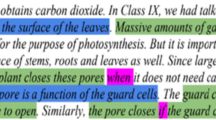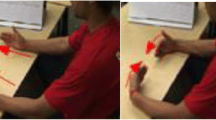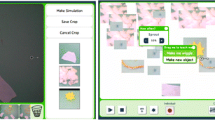Abstract
This paper sets out to examine how narrative modes of thinking play a part in the claiming of mathematical territories as our own, in navigating mathematical landscapes and in conversing with the mathematical beings that inhabit them. We begin by exploring what constitutes the narrative mode, drawing principally on four characteristics identified by Bruner and considering how these characteristics manifest themselves in the activities of mathematicians. Using these characteristics, we then analyse a number of examples from our work with expressive technologies; we seek to identify the narrative in the interactions of the learners with different computational microworlds. By reflecting on the learners’ stories, we highlight how particular features, common across the microworlds—motion, colour, sound and the like—provided the basis for both the physical and psychological grounding of the behaviour of the mathematically constrained computational objects. In this way, students constructed and used narratives that involved situating mathematical activities in familiar contexts, whilst simultaneously expressing these activities in ways which—at least potentially—transcend the particularities of the story told.





Similar content being viewed by others
Notes
While we are aware that some distinguish between narrative and story (see, for example, Abbott, 2002), in this paper we have adopted Bruner’s practice of using the terms interchangeably.
References
Abbott, H. P. (2002). The Cambridge introduction to narrative. Cambridge: Cambridge University Press.
Balacheff, N. (1988). Aspects of proof in pupils’ practice of school mathematics (D. Pimm, Trans.). In D. Pimm (Ed.), Mathematics, teachers and children (pp. 216–235). London: Hodder and Stoughton.
Balacheff, N. (1991). Treatment of refutations: Aspects of the complexity of a constructivist approach to mathematics learning. In E. von Glasersfeld (Ed.), Radical constructivism in mathematics education (pp. 89–110). Dordrecht: Kluwer Academic Publishers.
Brown, S. (1996). Towards humanistic mathematics education. In A. Bishop (Ed.), First international handbook in mathematics education (pp. 1289–1331). Dordrecht: Kluwer Academic Publishers.
Bruner, J. S. (1986). Actual minds, possible worlds. Cambridge, MA: Harvard University Press.
Bruner, J. S. (1996). The culture of education. Cambridge, MA: Harvard University Press.
Burton, L. (1996). Mathematics, and its learning, as narrative – A literacy for the twenty-first century. In D. Baker, J. Clay, & C. Fox (Eds.), Changing ways of knowing: In english, mathematics and science (pp. 29–40). London: Falmer Press.
Devlin, K. (2000). The math gene: How mathematical thinking evolved and why numbers are like gossip. New York: Basic Books.
Goldenberg, P., Lewis, P., & O’Keefe, J. (1992). Dynamic representation and the development of a process understanding of function. In G. Harel & E. Dubinsky (Eds.), The function concept: Aspects of epistemology and pedagogy (pp. 235–260). Washington, DC: Mathematical Association of America.
Graves, R. (1885). Life of Sir William Rowan Hamilton (Vol. 2). Dublin: Hodges, Figgis and Co.
Hamilton, W. (1844–1850). On quaternions; or on a new system of imaginaries in algebra. Philosophical Magazine, (Vols. 25–36) (Reprinted in H. Halberstam & R. Ingram (Vol. 3, Eds.). (1967). The mathematical papers of Sir William Rowan Hamilton (pp. 227–297)). Cambridge: Cambridge University Press.
Hofstadter, D. R. (1997). Discovery and dissection of a geometric gem. In J. R. King, & D. Schattschneider (Eds.), Geometry turned on!: Dynamic software in learning, teaching, and research (pp. 3–14). Washington, DC: The Mathematical Association of America.
Laborde, C. (1995). Designing tasks for learning geometry in a computer based environment. In L. Burton, & L. B. Jaworski (Eds.), Technology in mathematics teaching – a bridge between teaching and learning (pp. 35–68). London: Chartwell-Bratt.
Labov, W. (1972). The transformation of experience in narrative syntax. Philadelphia: University of Pennsylvania Press.
Lakoff, G., & Nunes, R. (2000). Where mathematics comes from. How the embodied mind brings mathematics into being. New York: Basic Books.
Minsky, M., & Papert, S. (1970). Draft of a proposal to ARPA for research on artificial intelligence at MIT, 1970–1971.
Papert, S. (1980). Mindstorms: Children, computers and powerful ideas. London: Harvester Press.
Papert, S. (1992). Foreword. In C. Hoyles, & R. Noss (Eds.), Learning mathematics and logo (pp. ix–xvi). Cambridge, MA: MIT Press.
Schiralli, M. & Sinclair, N. (2003). A constructive response to ‘Where mathematics comes from’. Educational Studies in Mathematics, 52(1), 79–91.
Sfard, A. (1994). Reification as the birth of metaphor. For the Learning of Mathematics, 14(1), 44–55.
Solomon, Y., & O’Neill, J. (1998). Mathematics and narrative. Language and Education, 12(3), 210–221.
Young, R., & Saver, J. (2001). The neurology of narrative. Substance 94/95, 30(1–2), 72–84.
Author information
Authors and Affiliations
Corresponding author
Rights and permissions
About this article
Cite this article
Healy, L., Sinclair, N. If this is our mathematics, what are our stories?. Int J Comput Math Learning 12, 3–21 (2007). https://doi.org/10.1007/s10758-006-9109-4
Received:
Accepted:
Published:
Issue Date:
DOI: https://doi.org/10.1007/s10758-006-9109-4




